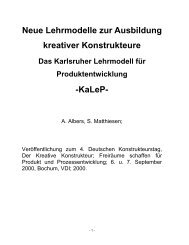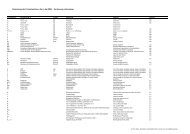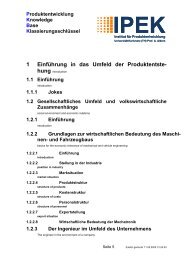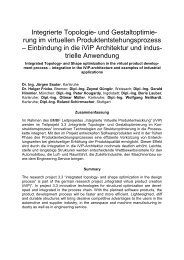SPALTEN - Methode - IPEK
SPALTEN - Methode - IPEK
SPALTEN - Methode - IPEK
You also want an ePaper? Increase the reach of your titles
YUMPU automatically turns print PDFs into web optimized ePapers that Google loves.
SS – Selection of Solutions<br />
Solutions that have been developed up to this stage are analyzed, evaluated and the most<br />
promising ones are selected. Therefore evaluation criteria have to be defined and weighted.<br />
As an additional step the selected solutions are examined with respect to safety and their<br />
influence on the selection of solutions. The plenitude of information on hand is decreased by<br />
repeated focusing on the most promising solution.<br />
LF – Level of Fulfillment<br />
Predictable risks and opportunities of the selected solutions are investigated in this module.<br />
Therefore critical spots are revealed, which facilitate the determination of risks/opportunities,<br />
causes, and identifying causes as such. An insight into the aforementioned allows to take<br />
action in order to avoid risks and to realize opportunities. The aim of the module, hence, is the<br />
implementation of these actions in the problem solving process. The plenitude of information<br />
is again increased by the multitude of risks and opportunities and the implementation of these.<br />
DI – Make Decision/Implement<br />
In this module, results of the foregoing two modules SS and LF are gathered and processed.<br />
The decision to implement the solution to the problem is documented and the implementation<br />
itself can be divided in three phases:<br />
� Planning<br />
� Carrying out<br />
� Finishing<br />
The goal of implementation is a complete processing and realization of the selected<br />
solution(s) in association with the integration of the previously determined actions for<br />
minimizing risks and optimizing opportunities. This module narrows the amount of<br />
information down.<br />
RL – Recapitulate/Learn<br />
The last module is based on the continuous improvement process (CIP). The aim of the<br />
module is to extract fundamental knowledge and optimized approaches from the experience<br />
made while processing the problem, for future reference in problem solving processes.<br />
Documentation of this improvement potential once more increases the plenitude of<br />
information and moves toward the opening of the information funnel of the honeycomb model<br />
Using the <strong>SPALTEN</strong>-Methodology – depending on the task – does not always require all<br />
modules, which may result in saving time. This way, through cause analysis directly<br />
following problem containment (PC) the origin of the problem may be detected ahead of time<br />
(for instance in the case of flawed components leading to an inability to deliver the product).<br />
The origin of the problem may of personal, company-related, supplier-related or associaterelated<br />
character. If the origin of the problem lies with a supplier, the task can be assigned to<br />
them. In case of a personal character of the problem’s origin, the solution does not necessitate<br />
a repeated process of solution research and selection, but a suitable way to monitor the supply<br />
of flawless parts. Beside this scenario two more cases can occur. The cause of the problem<br />
may be unclear, which has to be resolved by problem containment and subsequent search for<br />
alternative solutions. Alternatively, cause and path may be known and one or more solutions<br />
6








